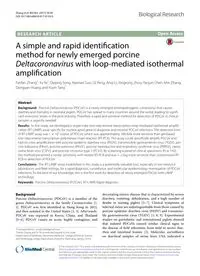
2017 A simple and rapid identification method for newly emerged porcine Deltacoronavirus with loop-mediated isothermal a PDF
Preview 2017 A simple and rapid identification method for newly emerged porcine Deltacoronavirus with loop-mediated isothermal a
Zhang et al. Biol Res (2017) 50:30 DOI 10.1186/s40659-017-0135-6 RESEARCH ARTICLE A simple and rapid identification method for newly emerged porcine Deltacoronavirus with loop-mediated isothermal amplification Fanfan Zhang†, Yu Ye†, Deping Song, Nannan Guo, Qi Peng, Anqi Li, Xingrong Zhou, Yanjun Chen, Min Zhang, Dongyan Huang and Yuxin Tang* Abstract Background: Porcine Deltacoronavirus (PDCoV) is a newly emerged enteropathogenic coronavirus that causes diarrhea and mortality in neonatal piglets. PDCoV has spread to many countries around the world, leading to signifi- cant economic losses in the pork industry. Therefore, a rapid and sensitive method for detection of PDCoV in clinical samples is urgently needed. Results: In this study, we developed a single-tube one-step reverse transcription loop-mediated isothermal amplifi- cation (RT-LAMP) assay specific for nucleocapsid gene to diagnose and monitor PDCoV infections. The detection limit of RT-LAMP assay was 1 × 101 copies of PDCoV, which was approximately 100-fold more sensitive than gel-based one-step reverse transcription polymerase chain reaction (RT-PCR). This assay could specifically amplify PDCoV and had no cross amplification with porcine epidemic diarrhea virus (PEDV), transmissible gastroenteritis virus (TGEV), por- cine kobuvirus (PKoV), porcine astrovirus (PAstV), porcine reproductive and respiratory syndrome virus (PRRSV), classic swine fever virus (CSFV), and porcine circovirus type 2 (PCV2). By screening a panel of clinical specimens (N = 192), this method presented a similar sensitivity with nested RT-PCR and was 1–2 log more sensitive than conventional RT- PCR in detection of PDCoV. Conclusions: The RT-LAMP assay established in this study is a potentially valuable tool, especially in low-resource laboratories and filed settings, for a rapid diagnosis, surveillance, and molecular epidemiology investigation of PDCoV infections. To the best of our knowledge, this is the first work for detection of newly emerged PDCoV with LAMP technology. Keywords: Porcine Deltacoronavirus (PDCoV), RT-LAMP, Rapid diagnosis © The Author(s) 2017. This article is distributed under the terms of the Creative Commons Attribution 4.0 International License (http://creativecommons.org/licenses/by/4.0/), which permits unrestricted use, distribution, and reproduction in any medium, provided you give appropriate credit to the original author(s) and the source, provide a link to the Creative Commons license, and indicate if changes were made. The Creative Commons Public Domain Dedication waiver (http://creativecommons.org/ publicdomain/zero/1.0/) applies to the data made available in this article, unless otherwise stated. Background Porcine Deltacoronavirus (PDCoV) is a member of the genus Deltacoronavirus in the family Coronaviridae [1, 2]. PDCoV was first identified in Hong Kong in 2012, and then isolated in the United States [2, 3]. Afterwards, PDCoV was reported in Korea, China, and Thailand [4–6]. PDCoV causes an acute, highly contagious, and devastating enteric disease that is characterized by severe diarrhea, vomiting, dehydration, and a high number of deaths in nursing piglets [3–7]. Clinical symptoms of infected swine are indistinguishable from those caused by porcine epidemic diarrhea virus (PEDV) and transmissi- ble gastroenteritis virus (TGEV) [3, 8, 9]. Experimental studies on gnotobiotic and conventional piglets showed that isolated PDCoVs caused similar clinical signs to the disease of field infections, from mild to severe diar- rhea and intestinal lesions [3]. Molecular surveillance on diarrheal samples of swine from USA indicated a Open Access Biological Research *Correspondence:
